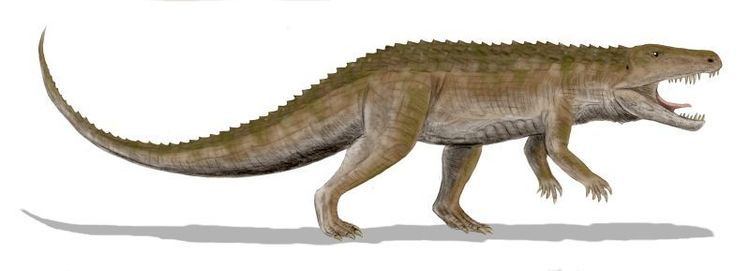Family †Stagonolepididae Phylum Chordata | Class Reptilia Subfamily †Typothoracisinae Order Aetosaur | |
 | ||
Genus †RedondasuchusHunt and Lucas, 1991 Similar | ||
Redondasuchus is an extinct genus of aetosaur. It may a junior synonym of Typothorax coccinarum, another aetosaur. Redondasuchus is a member of the clade Typothoracisinae within the subfamily Aetosaurinae, and lived during the middle Norian stage of the Late Triassic. Material belonging to the genus has been found from the Redonda Formation in east-central New Mexico. The type species, R. reseri, was named in 1991 after having been referred to as a species of Typothorax since 1985. A second species, R. rineharti, was described in 2006.
Contents
Description and species
Redondasuchus was first named with the description of the type species, R. reseri, in 1991. R. reseri was named on the basis of isolated scutes found at Apache Canyon and Shark Tooth Hill in Quay County, New Mexico. R. rineharti was described in 2006 from several scutes and part of a right femur found from Apache Canyon.
While other aetosaurs have scutes covered in pits and grooves that often form radial patterns, the scutes of Redondasuchus are densely covered in pits and lack any patterning. The dorsal paramedian scutes (those that line the back) are unique in that they are angled approximately 45°. In other aetosaurs, the scutes arc smoothly around the back from the midline to the lateral scutes that lie below them and run along the side of the animal.
The dorsal paramedians of R. reseri are smaller than those of R. rineharti. In both species, each paramedian possesses a keel on the underside that extends from the medial edge (the edge near the vertebrae) to the flexed area of the scute.
Orientation of scutes and plagiarism allegations
The orientation of the dorsal paramedian scutes of Redondasuchus has been disputed. Originally, it was thought that the angled part of the scute was two thirds the way down from the medial edge. The holotype of R. reseri was identified as a left paramedian based on the position of a bar that was known to lie on the anterior edge of the scute in other aetosaurs. However, a more recent study by Spielmann et al. (2006) has argued that the holotype scute is actually a right paramedian, claiming that the source of confusion was a mislabeling of the scute in the diagrams of previous papers. The orientation of one diagram, with the anterior margin being placed near the bottom of the page and the posterior margin near the top, may have contributed to its misidentification. This is because in most papers on aetosaurs, the anterior margin of a scute is positioned toward the top of the page and the posterior margin is positioned toward the bottom. If the scute is a right paramedian, the medial and lateral edges would be reversed, and the angled section would be one third the way down from the medial edge.
Four years before Spielmann et al. published their study of Redondasuchus, an unpublished thesis by Jeffrey Martz at Texas Tech University claimed that the holotype of R. reseri was actually a right paramedian (Martz also suggested that R. reseri was synonymous with Typothorax coccinarum). Martz, along with paleontologists Darren Naish, Mike Taylor, and Matt Wedel, later accused Spielmann et al. of committing plagiarism, claiming that the authors could not have come up with the same interpretation as Martz independently. This controversy became part of what was called Aetogate, involving several issues surrounding possible plagiarism by paleontologists at the New Mexico Museum of Natural History and Science.
Phylogeny
Heckert et al. (1996) considered Redondasuchus to be part of an advanced grade of aetosaurs that also included Neoaetosauroides, Longosuchus, Desmatosuchus, Paratypothorax, and Typothorax.
